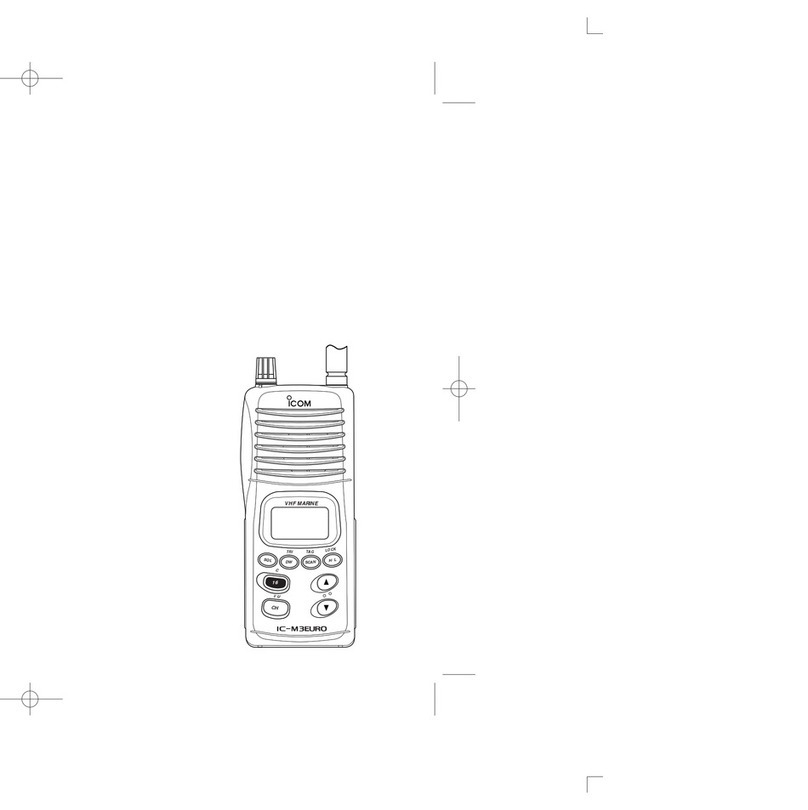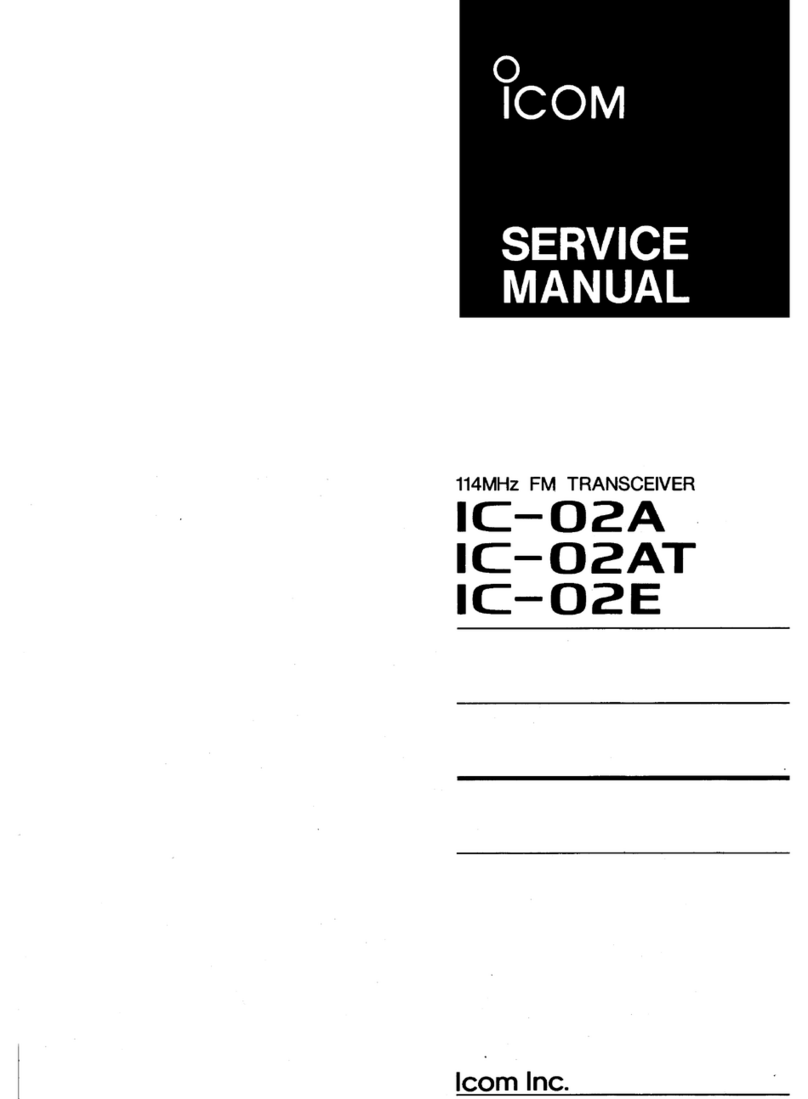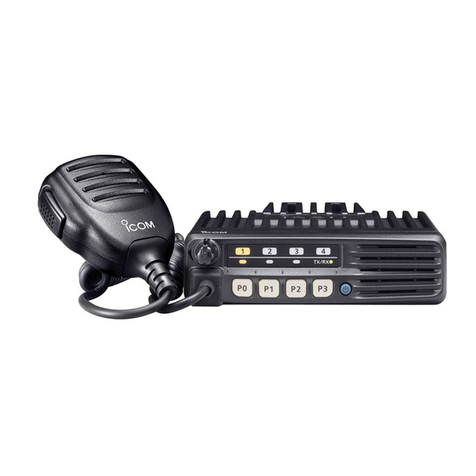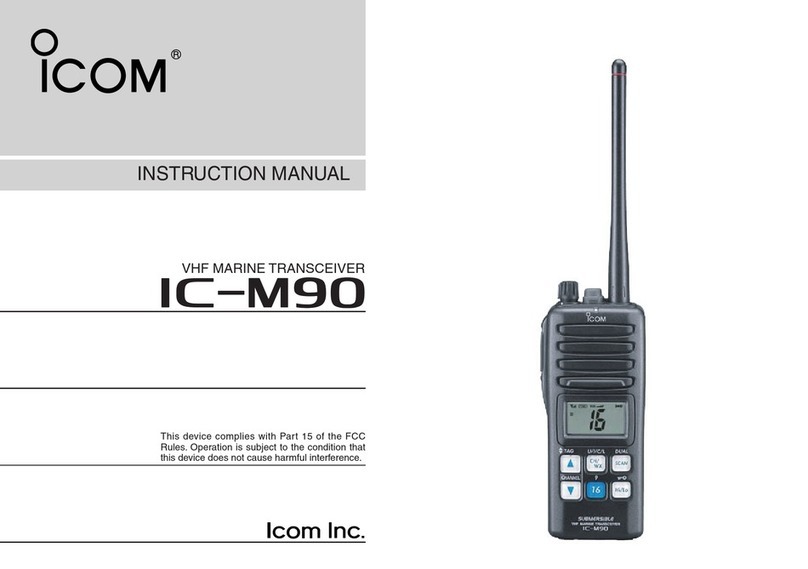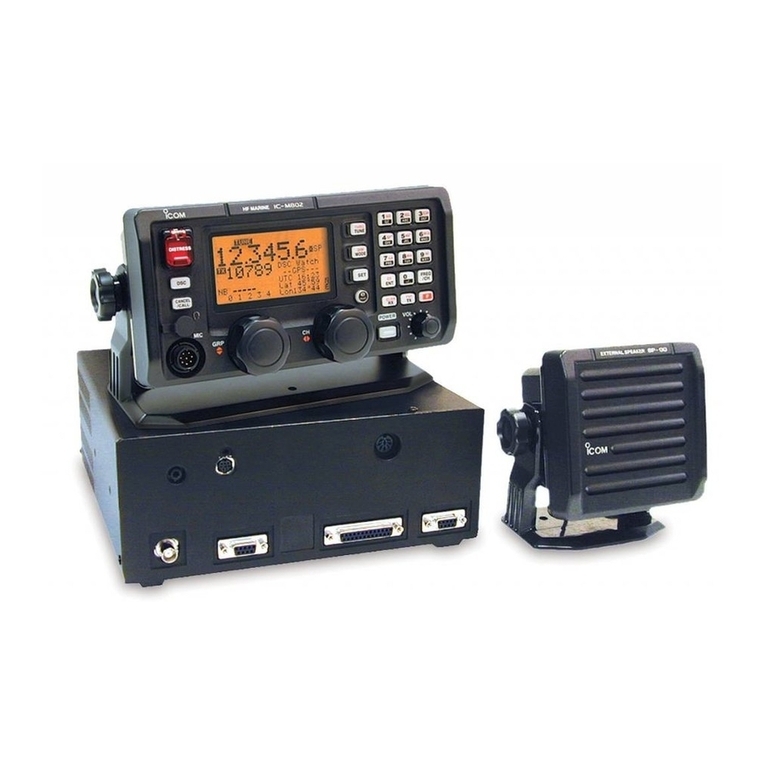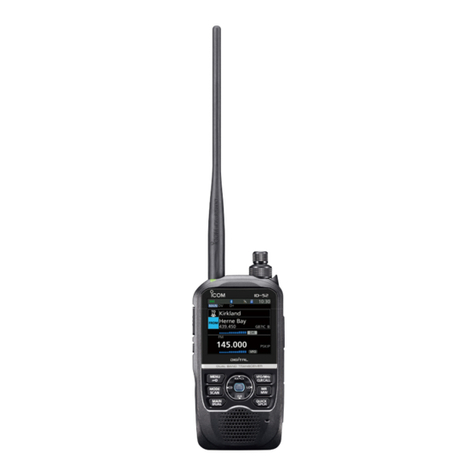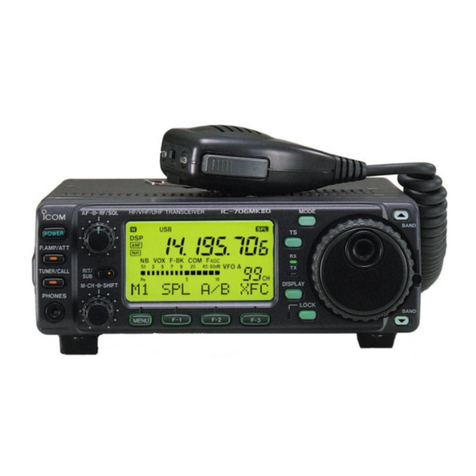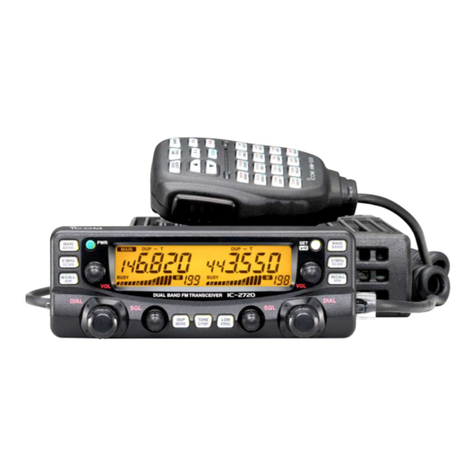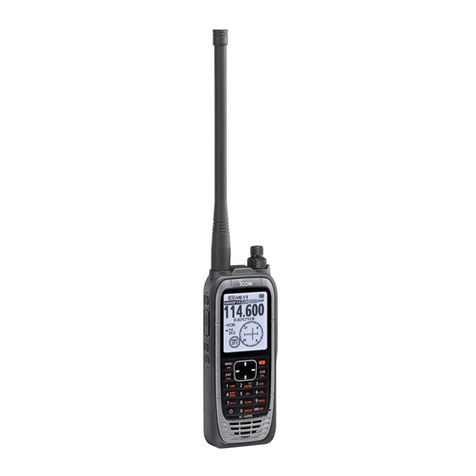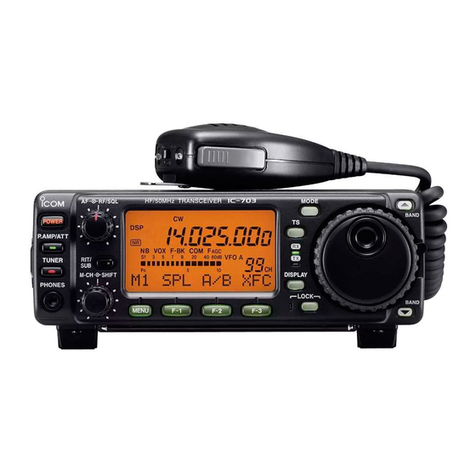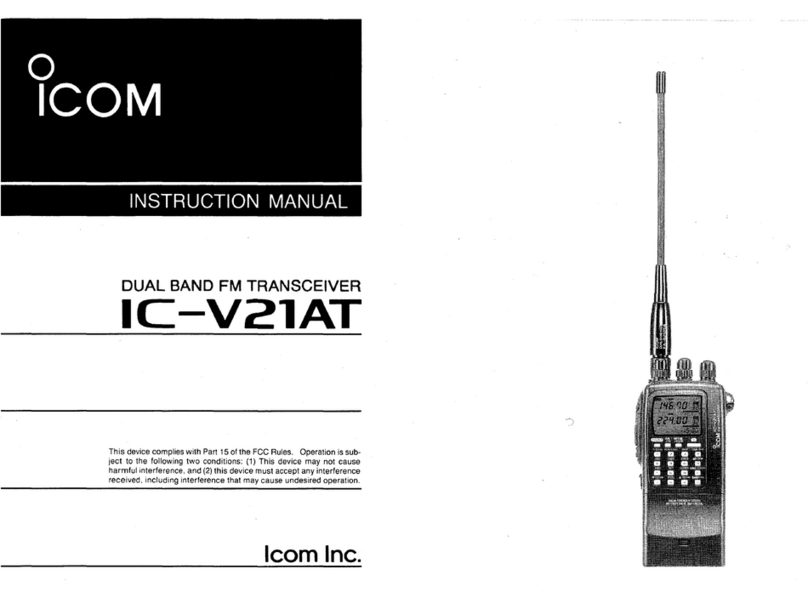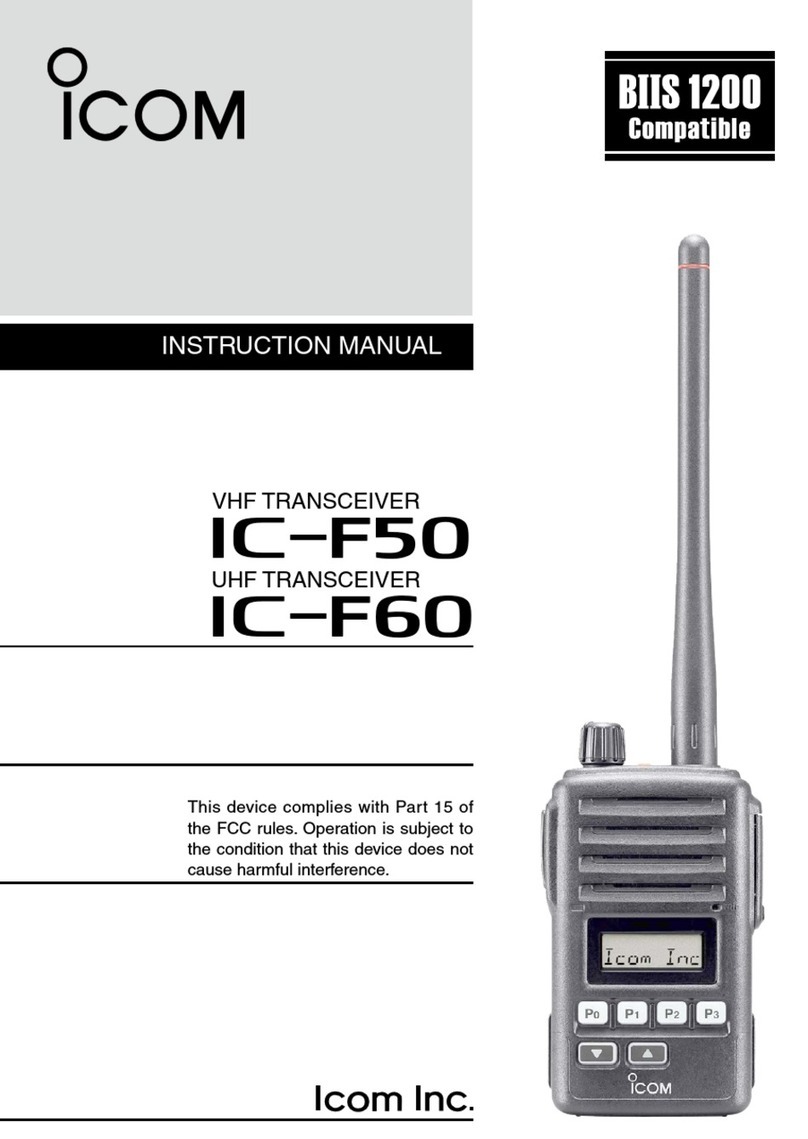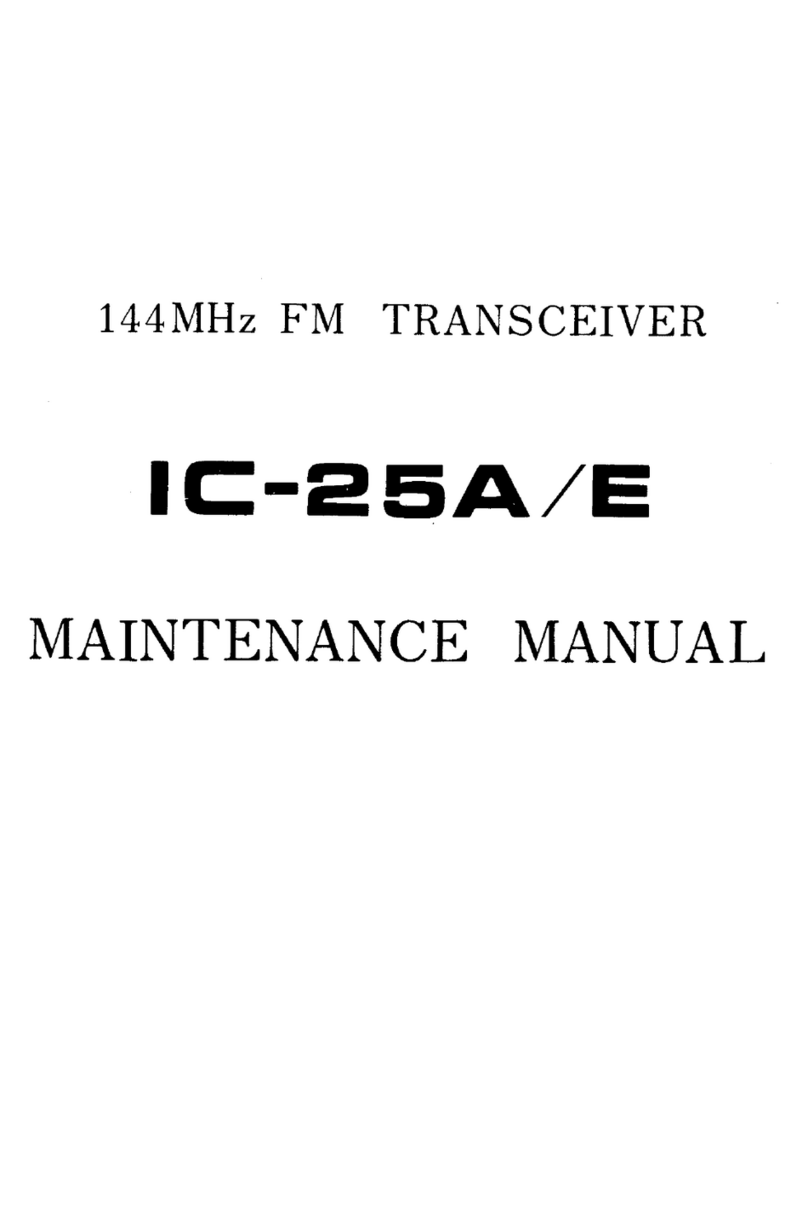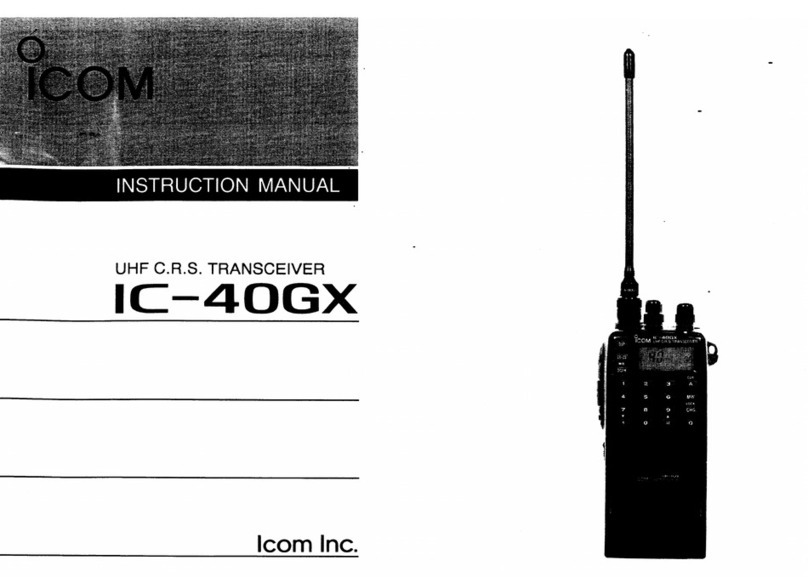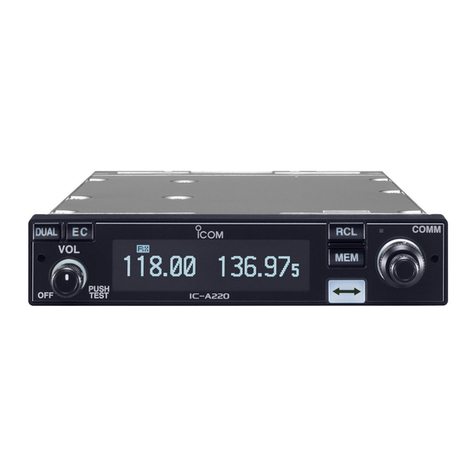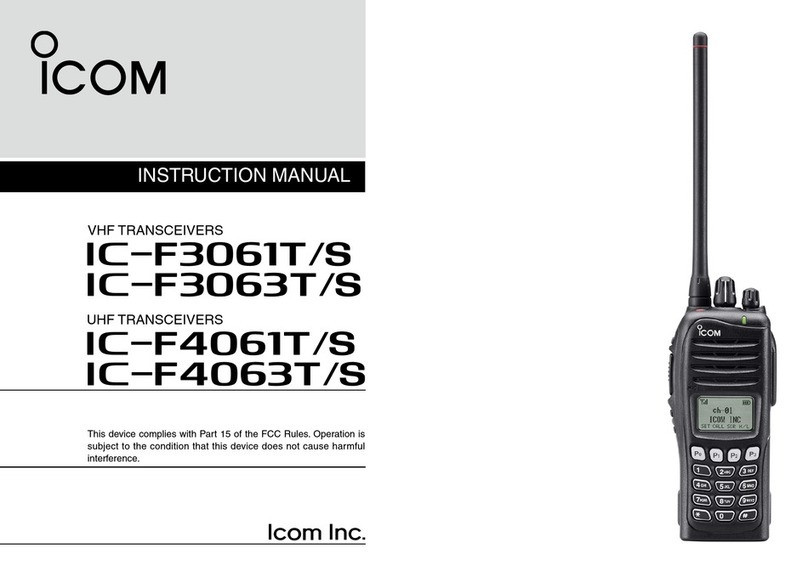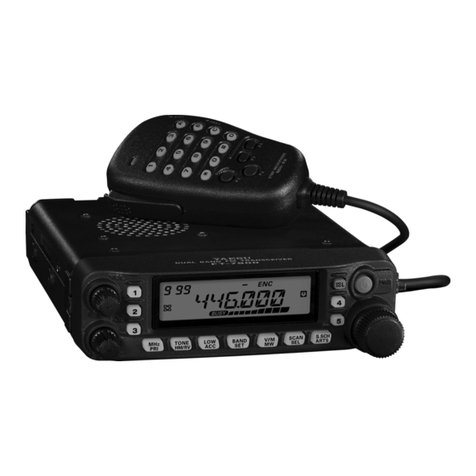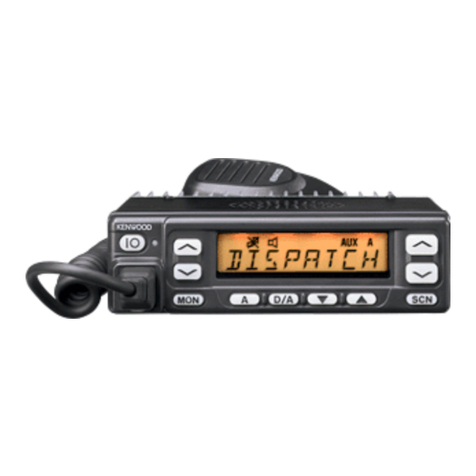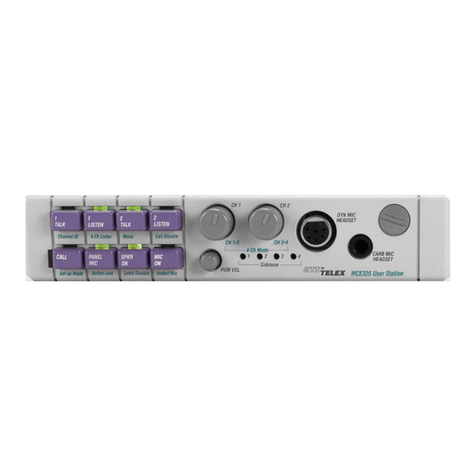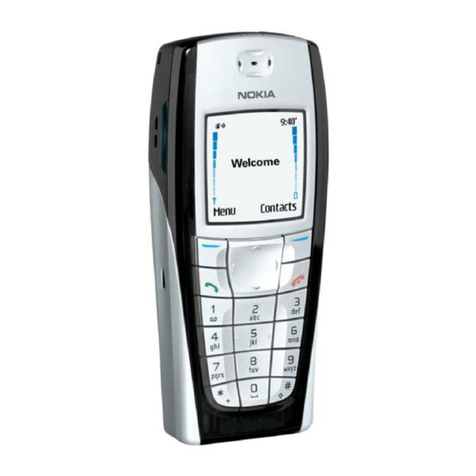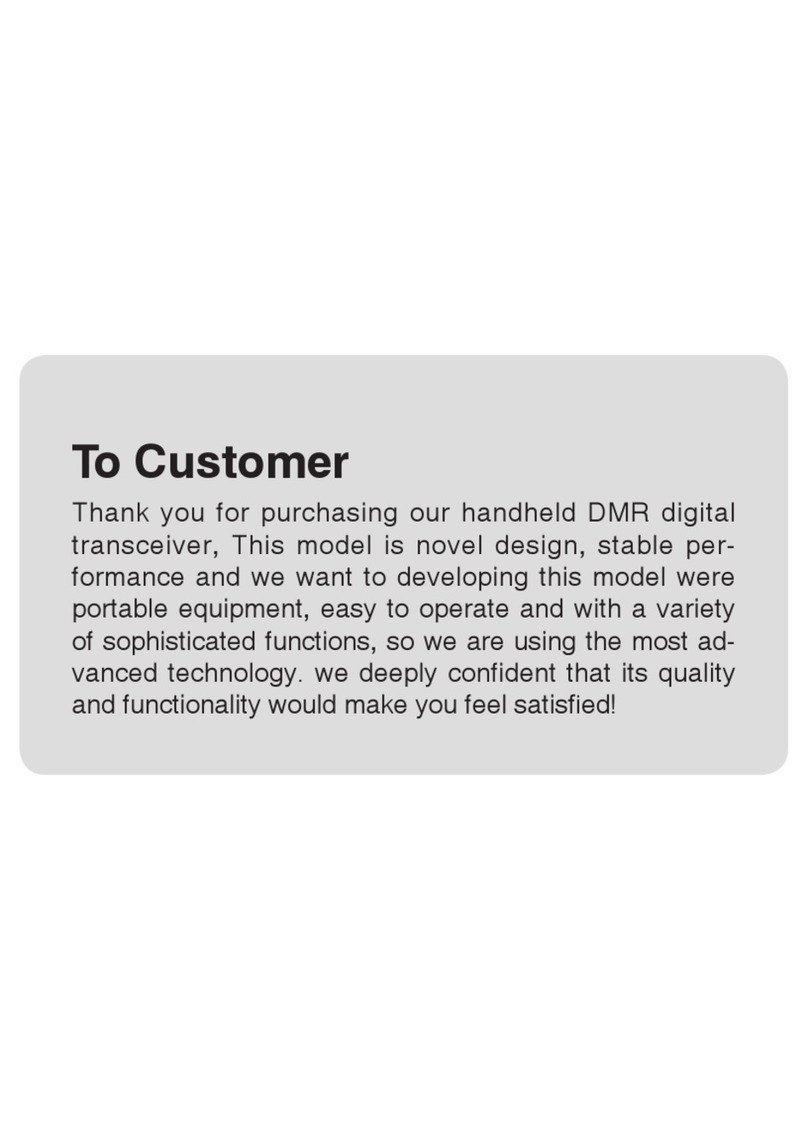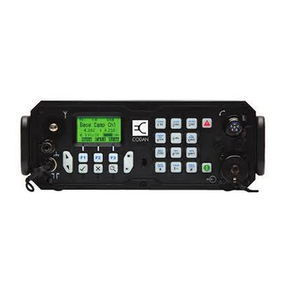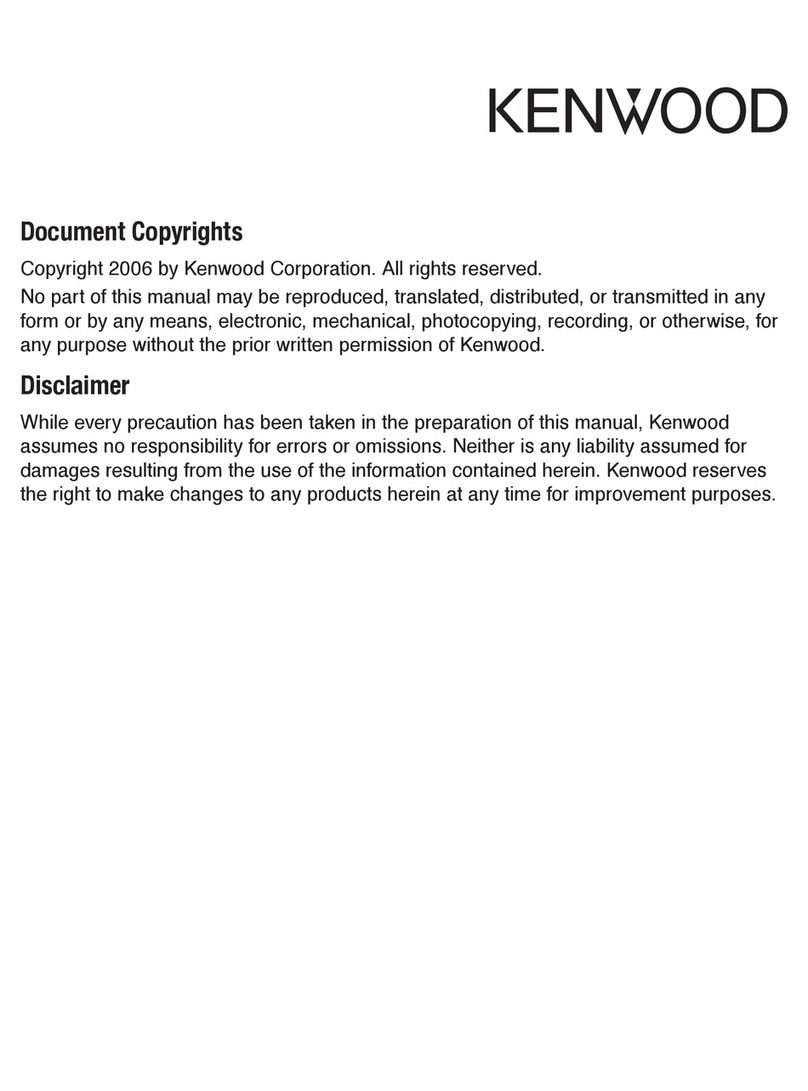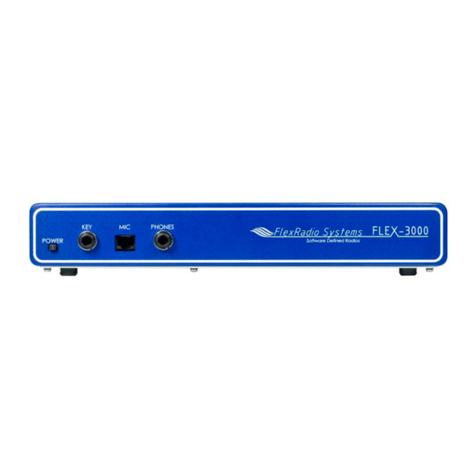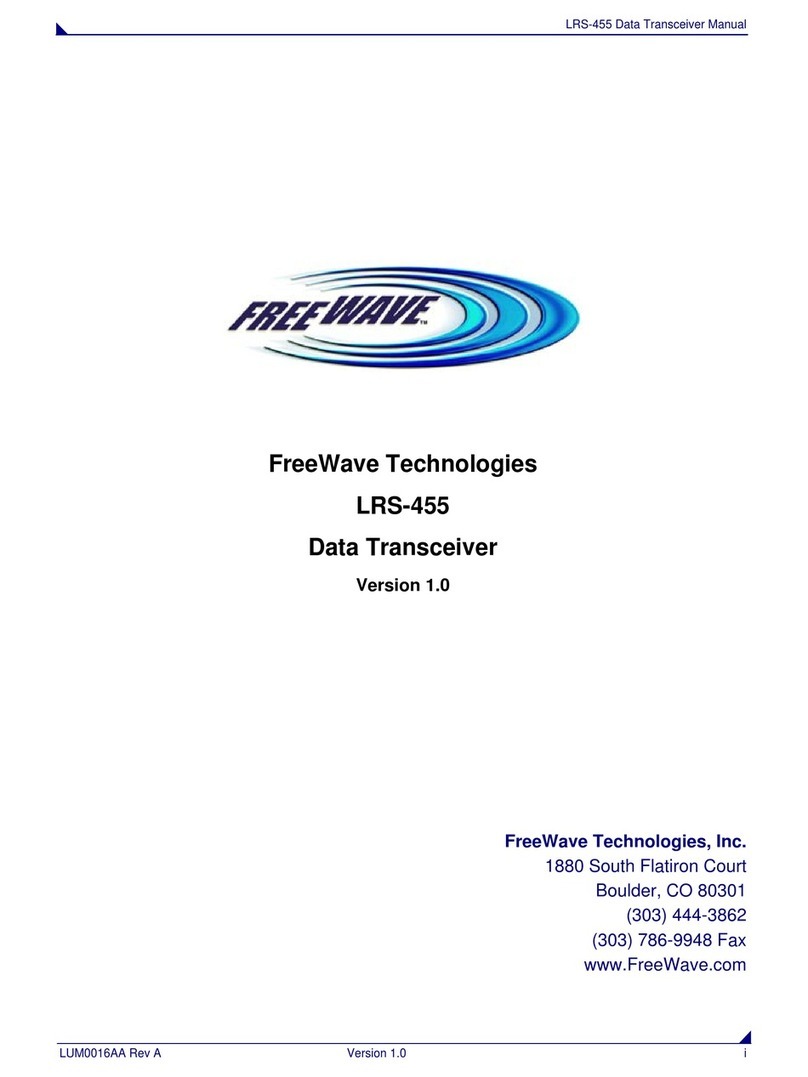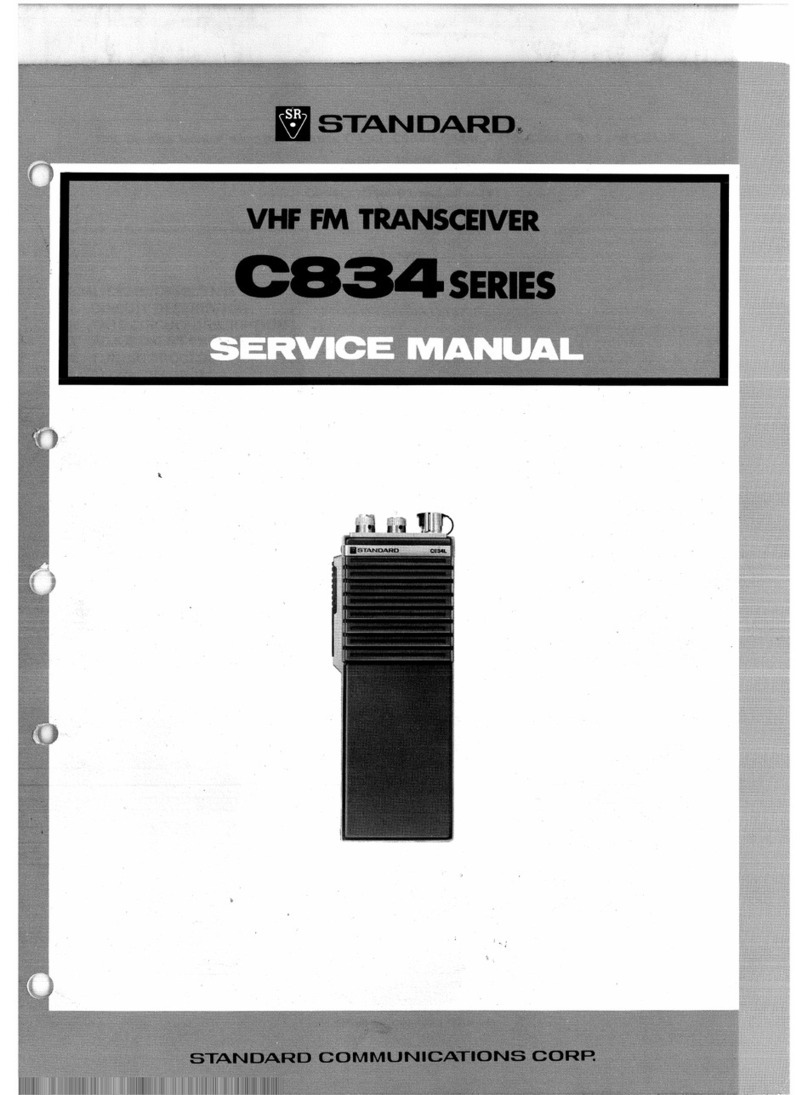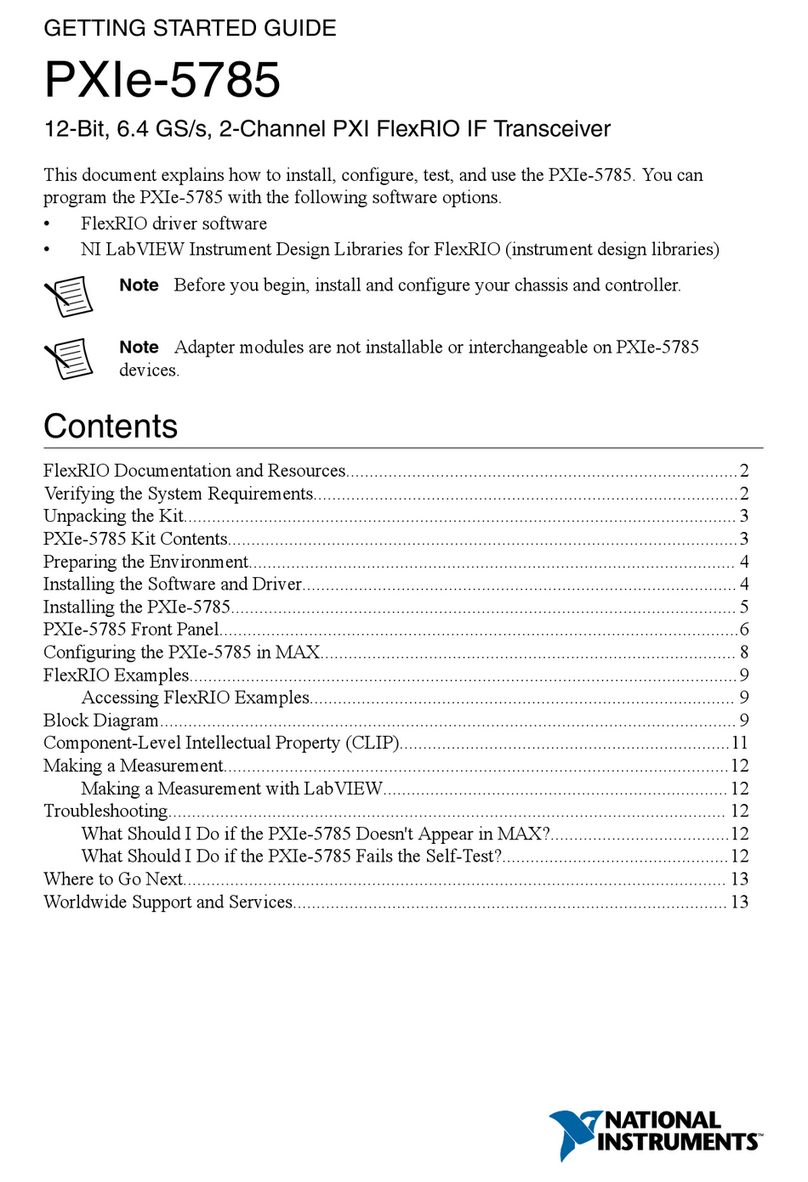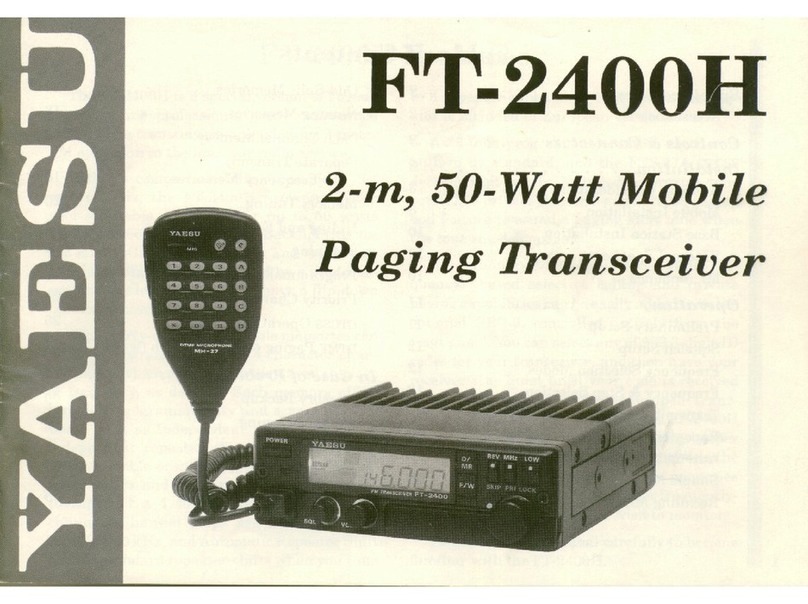Icom IC-F5062 User manual

INSTRUCTION MANUAL
UHF MOBILE TRANSCEIVER
iF6062
VHF MOBILE TRANSCEIVER
iF5062

i
RWARNING! NEVER connect the transceiver to an
AC outlet. This may pose a fire hazard or result in an electric
shock.
RWARNING! NEVER connect the transceiver to a
power source of more than 16 V DC such as a 24 V battery.
This connection will ruin the transceiver.
RWARNING! NEVER cut the DC power cable be-
tween the DC plug and fuse holder. If an incorrect connec-
tion is made after cutting, the transceiver might be damaged.
RWARNING! NEVER place the transceiver where
normal operation of the vehicle may be hindered or where it
could cause bodily injury.
CAUTION! NEVER allow children to touch the trans-
ceiver.
CAUTION! NEVER expose the transceiver to rain,
snow or any liquids.
USE the specified microphone only. Other microphones
have different pin assignments and may damage the trans-
ceiver.
READ ALL INSTRUCTIONS carefully and com-
pletely before using the transceiver.
SAVE THIS INSTRUCTION MANUAL — This
instruction manual contains important operating instructions
for the IC-F5062 and IC-F6062 VHF/UHF MOBILE TRANS-
CEIVERS.
EXPLICIT DEFENITIONS
WORD DEFINITION
RWARNING Personal injury, fire hazard or electric
shock may occur.
CAUTION Equipment damage may occur.
NOTE
If disregarded, inconvenience only. No risk
of personal injury, fire or electric shock.
See the operating guide for details of BIIS, MDC and LTR®
system operations. Ask your dealer for details.
Icom, Icom Inc. and the logo are registered trademarks of Icom Incor-
porated (Japan) in the United States, the United Kingdom, Germany, France,
Spain, Russia and/or other countries.
LTR is a registered trademark of the E.F.Johnson Company.
All other products or brands are registered trademarks or trademarks of their
respective holders.
IMPORTANT PRECAUTIONS

DO NOT use or place the transceiver in areas with tem-
peratures below –25°C or above +55°C, or in areas subject
to direct sunlight, such as the dashboard.
DO NOT operate the transceiver without running the ve-
hicle’s engine. The vehicle’s battery will quickly run out when
the transceiver transmits while the vehicle’s engine is OFF.
DO NOT place the transceiver in excessively dusty envi-
ronments.
DO NOT place the transceiver against walls. Otherwise
heat dissipation will be obstructed.
DO NOT use chemical agents such as benzine or alcohol
when cleaning, as they damage the transceiver surfaces.
BE CAREFUL! The transceiver will become hot when
operating continuously for long periods.
Icom optional equipment is designed for optimal perform-
ance when used with this transceiver. We are not respon-
sible for the transceiver being damaged or any accident
caused when using non-Icom optional equipment.
PRECAUTIONS TABLE OF CONTENTS
ii
1
2
3
4
5
6
7
8
9
10
11
12
13
14
15
16
IMPORTANT...................................................................................... i
EXPLICIT DEFENITIONS ................................................................. i
PRECAUTIONS................................................................................. i
TABLE OF CONTENTS.................................................................... ii
1 PANEL DESCRIPTION ...........................................................1−7
■ Front panel............................................................................... 1
■ Function display.......................................................................2
■ Programmable function keys ................................................... 3
2 BASIC OPERATION .............................................................8−13
■ Turning power ON....................................................................8
■ Channel selection ....................................................................8
■Call procedure .........................................................................9
■Receiving and transmitting ......................................................9
■User set mode .......................................................................12
■ Scrambler function.................................................................13
■ Emergency transmission .......................................................13
■ Stun function..........................................................................13
■ Priority A channel selection ...................................................13
3 CONNECTION AND MAINTENANCE................................14−17
■ Rear panel connection...........................................................14
■ Supplied Accessories ............................................................16
■ Mounting the transceiver .......................................................16
■ Antenna .................................................................................17
■ Fuse replacement..................................................................17
■ Cleaning.................................................................................17
■ Options ..................................................................................17
4 DOC ....................................................................................18−19

I c o m In c .
q e
y
SpeakerFunction display (p. 2)
w r
t
■Front panel
qAF VOLUME CONTROL KNOB [VOL]
Rotate the knob to adjust the desired audio output level.
• Minimum audio level is pre-programmed.
w LED INDICATOR
➥ Lights red while transmitting a signal.
➥ Lights green while receiving a signal.
eUP/DOWN KEYS [CH Up]/[CH Down]
Push to select an operating channel, etc.
*The desired function can be assigned by your dealer. (p. 3)
r POWER SWITCH [ ]
Push and hold for 1 sec. to turn the power ON and OFF.
• Automatic scan start, Password prompt and Set mode access
are available at power ON.
t DEALER-PROGRAMMABLE KEYS
Desired functions can be programmed independently by
your dealer. (p. 3)
y MICROPHONE CONNECTOR
Connect the supplied or optional microphone.
NEVER connect non-specified microphones. The pin
assignments may be different and the transceiver may
be damaged.
DMICROPHONE
The supplied microphone has a PTT switch and a hanger
hook.
• The following functions are available when the microphone is on or
off hook (depending on the setting):
- Automatic scan starts when it is on hook.
- Scan is cancelled when it is off hook.
- Scan is paused when it is off hook.
- Automatic priority channel selection is available when it is off
hook.
- Sets to ‘Inaudible’ condition (mute condition) when it is on hook.
-
Sets to ‘Audible’ condition (unmute condition) when it is off hook.
1
1PANEL DESCRIPTION

■Function display
I c o m I n c.
!1
q w e r t y u i o
!0
q SIGNAL STRENGTH INDICATOR
Indicates relative signal strength level as below.
Weak Receive Signal level Strong
w LOW POWER INDICATOR
Appears when low output power is selected.
eAUDIBLE INDICATOR
➥ Appears when the channel is in the ‘audible’ (unmute)
condition.
➥ Appears when the specified 2/5-tone/BIIS*1/MDC*2
code is received.
rCOMPANDER INDICATOR
Appears when the compander function is activated.
tSCRAMBLER INDICATOR
Appears when the voice scrambler function is activated.
yBELL INDICATOR
Appears/blinks when the specific 2/5-tone/BIIS*1/MDC*2
code is received, according to the pre-programming.
uCALL CODE MEMORY INDICATOR
➥ Appears when the call code memory is selected.
➥ Appears when a phone call is received.*3
iSCROLL INDICATOR
Appears when the SDM, includes more than 12 charac-
ters, is selected during the received message selection
mode*1.
oSDM INDICATOR
Appears when an SDM is received, or an SDM is se-
lected for transmission.*1
!0 ALPHANUMERIC DISPLAY
➥ Displays an operating channel number, channel name,
Set mode contents, DTMF code, etc.
➥The indication mode can be selected from 1 line or 2
lines. Ask your dealer for details.
• In this instruction manual, the LCD illustration is described
using the 2 lines indication mode.
!1 ACTIVATED KEY INDICATOR
Appears above the key assigned as [Scan A Start/
Stop], [Scan B Start/Stop], [Scan Add/Del(Tag)], [Lock],
[Talk Around], [Surveillance] and [BIIS button]*1keys dur-
ing that key is activated.
*1BIIS operation only *2MDC operation only
*3LTR®operation only
See the operating guide for details of BIIS, MDC and LTR®
system operations. Ask your dealer for details.
2
1
PANEL DESCRIPTION
1
2
3
4
5
6
7
8
9
10
11
12
13
14
15
16

3
1PANEL DESCRIPTION
■Programmable function keys
The following functions can be assigned to [UP], [DOWN],
[P0], [P1], [P2], [P3] and [P4] programmable function keys.
Consult your Icom dealer or system operator for details con-
cerning your transceivers programming.
If the programmable function names are bracketed in the fol-
lowing explanations, the specific key is used to activate the
function depends on the programming.
CH UP AND DOWN KEYS
➥Push to select an operating channel.
➥Push to select a transmit code channel after pushing [TX
Code CH Select].
➥Push to select a DTMF channel after pushing [DTMF Au-
todial].
➥Push to select a scan group after pushing and holding
[Scan A Start/Stop]/[Scan B Start/Stop] for 1 sec.
ZONE KEY
Push this key, then select the desired zone using [CH Up]/
[CH Down].
What is “zone”?—The desired channels are assigned
into a zone according to the intended use for grouping.
For example, ‘Staff A’ and ‘Staff B’ are assigned into a
“Business” zone, and ‘John’ and ‘Cindy’ are assigned into
a “Private” zone.
ZONE UP AND DOWN KEYS
Push to select an operating zone.
SCAN A KEY
➥Push to start and cancel scanning operation.
• When Power ON Scan function is activated, push to pause the
scanning operation. And the paused scan resumes after the
specified time period has passed.
➥Push and hold this key for 1 sec. to indicate the scan list,
then push [CH Up] or [CH Down] to select the desired list.
SCAN B KEY
➥Push to start and cancel scanning operation.
The scan restarts after the specified time period has
passed when the scan (started with this key) is cancelled
by except for this key operation.
➥
Push and hold this key for 1 sec. to indicate the scan list,
then push [CH Up] or [CH Down] to select the desired list.

4
1
PANEL DESCRIPTION
1
SCAN ADD/DEL (TAG) KEY
➥Push to add or delete the selected channel to/from the
scan group.
1.
Push to indicate the scan group, then push [CH Up] or [CH Down]
to select the desired group.
2. Push to add or delete the channel to/from the selected scan
group.
3. Push and hold for 1 sec. to exit the scan group selection mode.
➥Push this key while scan is paused (a signal is detected)
on a channel (except for priority channel,) the channel is
cleared from the scan group.
Depending on the setting, the cleared channel is added
to the scan group again after the scan is cancelled.
PRIO A/B KEYS
➥Push to select Priority A or Priority B channel.
➥Push and hold [Prio A (Rewrite)] or [Prio B (Rewrite)] for
1 sec. to rewrite the operating channel as the Priority A or
Priority B channel.
MR-CH 1/2/3/4 KEYS
Push to select the memory channel 1 to 4 directly.
MONI (AUDI) KEY
➥Push to mute and release the CTCSS (DTCS) or 2-tone
squelch mute. Open any squelch/deactivate any mute
while pushing and holding this key. (LMR operation only)
➥Activates one of (or two of) the following functions on
each channel independently: (PMR operation only)
• Push and hold to un-mute the channel (audio is emitted; ‘Audi-
ble’ condition).
• Push to mute the channel (sets to ‘Inaudible’ only).
• Push to un-mute the channel (sets to ‘Audible’ only).
• Push after the communication is finished to send a ‘reset code’.
(5-tone/BIIS operation only)
NOTE: The un-mute condition (‘Audible’ condition) may
automatically return to the mute condition (‘Inaudible’ con-
dition) after a specified period depending on programming.
PUBLIC ADDRESS KEY
Push to activate the Public Address (PA) function for voice
amplification. When the PA function is activated, the audio
output can be controlled from the transceiver separately with
[CH Up]/[CH Down].
• This function is available when the external unit, such as a audio
amplifier, speaker, etc. is additionally connected.
• Push this key, then speak into the microphone while pushing and
holding [PTT].

5
1PANEL DESCRIPTION
RX SPEAKER KEY
Push to turn the RX speaker function ON or OFF.
When the RX speaker function is turned ON, the received
audio can be heard via the external speaker.
• This function is available when the external speaker is additionally
connected.
• This function is useful when you are out of the vehicle.
• The audio output level is linked to the transceiver’s volume control.
LIGHT KEY
Push to turn the transceiver’s backlight ON for about 5 sec.
when the backlight function is turned OFF in user set mode.
LOCK KEY
Push and hold to electronically lock all programmable keys
except the following:
[Moni(Audi)], [Light], [Lock], [Call] (incl. Call A and Call B),
[Emergency Single], [Surveillance], [Lone Worker] and [OPT 1/2/3].
LONE WORKER KEY
Push to turn the Lone Worker function ON or OFF.
• If the Lone Worker function is activated, the Emergency function is
automatically turned ON after the specified time period has passed
with no operation is performed.
HIGH/LOW KEY
Push to select the transmit output power temporarily or per-
manently, depending on the pre-setting.
• Ask your dealer for the output power level for each selection.
TONE/RAN CH SELECT KEY
➥While in analog mode operation, push to enter the con-
tinuous tone channel selection mode. Then select the
desired tone frequency/code setting with [CH Up] or
[CH Down]. After the selection, push this key again to set.
➥While in digital mode operation*, push to enter the RAN
channel selection mode. Then select the desired RAN set-
ting with [CH Up] or [CH Down]. After the selection, push
this key again to set.
➥While in mixed (digital and analog) mode operation*, push
to enter the continuous tone channel selection mode.
Then select the desired tone frequency/code setting with
[CH Up] or [CH Down]. After the selection, push this key
to set. After that, the RAN channel selection screen ap-
pears. Select the desired RAN setting with [CH Up] or
[CH Down]. After the selection, push this key again to set.
* Digital and mixed (digital and analog) mode operations are avail-
able only when the optional UT-126H digital modulator/demodu-
lator unit is installed. Ask your dealer for details.
C.TONE CH ENT KEY
Push to enter the continuous tone channel selection mode.
Then select the desired tone frequency/code setting with
[CH Up] or [CH Down]. The selected channel remains set as
the continuous tone channel until another channel is desig-
nated as such.

6
1
PANEL DESCRIPTION
1
TALK AROUND KEY
Push to turn the talk around function ON and OFF.
• The talk around function equalizes the transmit frequency to the
receive frequency for transceiver-to-transceiver communication.
WIDE/NARROW KEY
Push to toggle the IF bandwidth between wide and narrow.
• The wide passband width can be selected from 25.0 or 20.0 kHz
using the CS-F3160/F5060 cloning software. (PMR operation
only) Ask your dealer for details.
DTMF AUTODIAL KEY
Push to enter the DTMF channel selection mode. Then select
the desired DTMF channel using [CH Up]/[CH Down].
After selecting the DTMF channel, push again to transmit
the selected DTMF code.
RE-DIAL KEY
Push to transmit the last-transmitted DTMF code.
• TX memories are cleared after turning the transceiver OFF.
CALL KEYS
Push to transmit a 2/5-tone/BIIS ID code.
• Call transmission is necessary before calling another station
depending on your signalling system.
• [Call A] and/or [Call B] may be available when your system
employs selective ‘Individual/Group’ calls. Ask your dealer which
call is assigned to each key.
EMERGENCY KEY
Push and hold to transmit the emergency call.
• The emergency call transmits with beeps; the display does not
change.
• The transceiver can transmit the emergency call silently or with the
display changes depending on the pre-setting. Ask your dealer for
details.
• If you want to cancel the emergency call, push and hold the key
again before transmitting the call.
• The emergency call is transmitted one time only or repeatedly until
receiving a control code, depending on the pre-setting.
SURVEILLANCE KEY
Push to turn the surveillance function ON or OFF.
When this function is turned ON, the beep is not emitted and
the LCD backlight and the LED indicator do not light when a
signal is received or a key is pushed.
TX CODE ENTER KEY (PMR operation only)
Push to enter the ID code edit mode directly, for both
5-tone and MSK. Then set the desired digit using [CH Up]/
[CH Down]. (p. 11)
TX CODE CHANNEL SELECT KEY
➥Push to enter the ID code channel selection mode
directly. Then set the desired channel using [CH Up]/
[CH Down]. (p. 10)
➥During ID code channel selection mode, push for 1 sec.
to enter the ID code edit mode for 5-tone and MSK. Then
set the desired digit using [CH Up]/[CH Down]. (p. 11)

7
1PANEL DESCRIPTION
TX CODE CHANNEL UP/DOWN KEYS
Push to select a TX code channel directly.
SCRAMBLER/ENCRYPTION KEY
➥While in analog mode operation, push to toggle the voice
scrambler function ON and OFF.
➥While in digital mode operation*, push to toggle the
encryption transmission function ON and OFF.
* Digital mode operation is available only when the optional UT-
126H digital modulator/demodulator unit is installed. Ask your
dealer for details.
COMPANDER KEY
Push to toggle the compander function ON and OFF.
The compander function reduces noise components from
the transmitted audio to provide clear communication.
ID-MR SELECT KEY (PMR operation only)
➥Recalls detected ID codes.
• Push this key, then select the ID code using [CH Up]/
[CH Down].
• Up to 5 ID’s are memorized.
➥Push and hold for 1 sec. to erase the selected ID’s.
HOOK SCAN KEY
When the on hook scan function is activated, push this key
to disables on hook scan function (stop scanning) temporar-
ily. Push this key again to re-start scanning.
USER SET MODE KEY
➥Push and hold for 1 sec. to enter user set mode.
• During user set mode, push this key to select an item, and
change the value or condition using push [CH Up]/[CH Down].
➥Push and hold this key for 1 sec. again to exit user set
mode.
User set mode is also available via the ‘Power ON function.’
Refer to p. 12 also.
10Key ENT KEY
Push to enable the connected microphone's 10-keypad
operation.
• The desired memory channel, TX code channel (5-tone) or TX
status (MSK) can be selected with the microphone's 10-keypad
operation. (Depends on the pre-programming.)
OPT 1/2/3 KEYS
Push to control the output signal level from the optional unit
connector.

8
2
BASIC OPERATION
1
2
3
4
5
6
7
8
9
10
11
12
13
14
15
16
■Turning power ON
qPush and hold [ ] for 1 sec. to turn the power ON.
wIf the transceiver is programmed for a start up password,
input the digit codes as directed by your dealer.
• The keys as below can be used for password input:
The transceiver detects numbers in the same block as identical.
Therefore “01234” and “56789” are the same.
eWhen the “PASSWORD” indication does not clear after
inputting 6 digits, the input code number may be incorrect.
Turn the power off and start over in this case.
■Channel selection
Several types of channel selections are available. Methods
may differ according to your system set up.
NON-ZONE TYPE:
To select the desired operating channel:
• Push [CH Up] or [CH Down].
• Push one of [MR-CH 1] to [MR-CH 4].
ZONE TYPE:
To select the desired zone:
• Push [Zone], then push [CH Up] or [CH Down].
• Push [Zone Up] or [Zone Down].
DVoting operation
The transceiver automatically starts scanning when a zone,
specified for the voting operation, is selected.
The voting scan detects the S-meter of the repeater and au-
tomatically selects the strongest station.
AUTOMATIC SCAN TYPE:
Channel setting is not necessary for this type. When turning
power ON, the transceiver automatically starts scanning.
Scanning stops when receiving a call.
KEY
NUMBER 0
5
4
9
3
8
2
7
1
6

■Call procedure
When your system employs tone signaling (excluding
CTCSS and DTCS), a call procedure may be necessary
prior to voice transmission. The tone signalling employed
may be a selective calling system which allows you to call
specific station(s) only and prevent unwanted stations from
contacting you.
qSelect the desired TX code channel or 2/5-tone code ac-
cording to your System Operator’s instructions.
• This may not be necessary depending on programming.
• Refer to pgs. 10–11 for selection.
wPush [Call] (assigned to one of the dealer programmable
keys).
eAfter transmitting, the remainder of your communication
can be carried out in the normal fashion.
Selective calling Non-selective calling
■Receiving and transmitting
Receiving:
qPush and hold [ ] for 1 sec. to turn the power ON.
wPush [CH Up] or [CH Down] to select the conventional
system channel, in sequence.
eWhen receiving a call, rotate [VOL] to adjust the audio
output level to a comfortable listening level.
Transmitting:
Wait for the channel to become clear to avoid interference.
qTake the microphone off hook.
• 2/5-tone mute may be released. (The ‘audible’ condition is se-
lected and BUSY indicator lights green.)
• A priority channel may be selected automatically.
wWait for the channel to become clear.
• The channel is busy when BUSY indicator lights green.
eWhile pushing and holding [PTT], speak into the micro-
phone at your normal voice level.
rRelease [PTT] to return to receive.
IMPORTANT: To maximize the readability of your signal;
1. Pause briefly after pushing [PTT].
2. Hold the microphone 5 to 10 cm (2 to 4 inches) from
your mouth, then speak into the microphone at a nor-
mal voice level.
9
2BASIC OPERATION

10
2
BASIC OPERATION
1
2
3
4
5
6
7
8
9
10
11
12
13
14
15
16
DTransmitting notes
• Transmit inhibit function
The transceiver has several inhibit functions which restrict
transmission under the following conditions:
- The channel is in mute condition (‘Inaudible’ condition;
“ ” (Audible indicator) does not appear.)
- The channel is busy.
- Un-matched (or matched)* CTCSS is received.
*Depending on the pre-setting
- The selected channel is a ‘receive only’ channel.
• Time-out timer
After continuous transmission for the pre-programmed time
period, the time-out timer is activated, causing the trans-
ceiver to stop transmitting.
• Penalty timer
Once the time-out timer is activated, transmission is further
inhibited for a period determined by the penalty timer.
DTX code channel selection
If the transceiver has [TX Code CH Select] assigned to it,
the indication can be toggled between the operating channel
number (or name) and TX code channel number (or name).
When the TX code channel number (or name) is displayed,
[CH Up] or [CH Down] selects the TX code channel.
USING [TX CODE CH SELECT] KEY:
qPush [TX Code CH Select]— a TX code channel number
(or name) appears.
wPush [CH Up] or [CH Down] to select the desired TX code
channel.
eAfter selecting, push [TX Code CH Select] to set.
• Return to the stand-by mode.
rPush [Call] to transmit the selected TX code.
USING [TX CODE CH UP]/[TX CODE CH DOWN] KEY:
If the transceiver has a [TX Code CH Up] or [TX Code CH
Down] key assignment, the programmed TX code channel
can be selected directly when pushed.

11
2BASIC OPERATION
DTX code number edit (PMR operation only)
If the transceiver has [TX Code CH Select] or [TX Code
Enter] assigned to it, TX code contents can be edited within
the allowable digits.
USING [TX CODE CH SELECT] KEY:
qPush [TX Code CH Select] to enter the TX code channel
selection mode.
• Select the desired channel before entering the TX code chan-
nel selection mode if necessary.
wPush and hold [TX Code CH Select] for 1 sec. to enter
the TX code edit mode.
• The digit to be edited blinks.
ePush [TX Code CH Select] to select the desired digit to
be edited.
rPush [CH Up] or [CH Down] to set the desired digit.
tPush [TX Code CH Select] to set. The digit to the right will
blink automatically.
yRepeat steps rand tto edit all allowable digits.
uAfter editing, push [TX Code CH Select] to set.
• Return to the stand-by mode.
iPush [Call] to transmit.
USING [TX CODE ENTER] KEY:
qPush [TX Code Enter] to enter the TX code edit mode.
• The digit to be edited blinks.
wPush [TX Code Enter] to select the desired digit to be ed-
ited.
ePush [CH Up] or [CH Down] to select the desired digit.
rPush [TX Code Enter] to set. The digit to the right will
blink automatically.
tRepeat steps eand rto input all allowable digits.
yAfter editing, push [TX Code Enter] to set.
• Return to the stand-by mode.
uPush [Call] to transmit.
DDTMF transmission
If the transceiver has [DTMF Autodial] assigned to it, the
automatic DTMF transmission function is available. Up to 8
DTMF channels are available.
qPush [DTMF Autodial]— a DTMF channel appears.
wPush [CH Up] or [CH Down] to select the desired DTMF
channel.
ePush [DTMF Autodial] to transmit the DTMF code.

12
2
BASIC OPERATION
1
2
3
4
5
6
7
8
9
10
11
12
13
14
15
16
■User set mode
User set mode is accessed with [User Set Mode] and allows
you to set seldom-changed settings. In this case you can
“customize” the transceiver operation to suit your prefer-
ences and operating style.
Entering the user set mode:
qWhile pushing and holding [P1] and [P2], push [ ] to turn
the power ON.
• Turn power OFF in advance.
• You should hold [P1] and [P2] until “SET MODE” appears on
the display.
[P1] [P2] [ ]
wPush and hold [P0] for 1 sec. to enter user set mode.
[P0]
ePush [P0] several times to select the appropriate item.
Then, push [Up] or [Down] to set the desired level/condi-
tion.
• Available set mode functions are Backlight, LCD Contrast,
Beep, Beep Level, Ringer Level, Squelch Level, AF Mini-
mum Level, Microphone Gain, Horn, Signal Monitor and
Lone Worker.
[P0] [Up]/[Down]
rPush and hold [ ] for 1 sec. to turn power OFF, then ON
again to exit set mode.
[ ]
User set mode is also available using a programmable key.
Please refer to p. 7 [User Set Mode] section for instructions
regarding using the key assigned for user set mode.
NOTE: [Up], [Down] and [P0] activate while in the user
set mode regardless of the assigned key functions.

13
2BASIC OPERATION
■Scrambler function
The voice scrambler function provides private communi-
cation between stations. The frequency inversion type is
equipped to all versions, moreover, the optional Rolling or
Non-rolling type can be available.
qPush [Scrambler] to turn the scrambler function ON.
• “ ” appears.
wPush [Scrambler] again to turn the scrambler function
OFF.
• “ ” disappears.
■Emergency transmission
When [Emergency] is pushed for the specified time period,
an emergency signal is automatically transmitted. (p. 6)
When [Emergency] is pushed for the specified time period,
the DTMF or 5-tone* emergency signal is transmitted once
or repeatedly on the emergency channel. However, when no
emergency channel is specified, the signal is transmitted on
the previously selected channel.
If you want to cancel the emergency call, push and hold the
key again before transmitting the call.
* Depending on the operating model type.
■Stun function
When the specified ID, set as a kill ID, is received, the stun
function is activated.
When the kill ID is received, the transceiver switches to the
password required condition. Entering of the password (p. 8)
is necessary to operate the transceiver again in this case.
■Priority A channel selection
When one of the following operations is performed, the
transceiver selects the Priority A channel automatically.
• Turning the power ON
The Priority A channel is selected each time the trans-
ceiver power is turned ON.
• Status call
The Priority A channel is selected when transmitting a sta-
tus call. (BIIS operation only)
• Off hook.
The Priority A channel is selected when the microhone is
took off from its hanger.

14
3
CONNECTION AND MAINTENANCE
1
2
3
4
5
6
7
8
9
10
11
12
13
14
15
16
■Rear panel connection
DFor mobile operation
Black
Red
12V
Battery
RCAUTION! NEVER
remove the fuse-holder
from the DC power cable.
q
D-Sub 25-pin
Connect an external unit.
t
r
y
Optional
speaker
e
w
Microphone
ANTENNA CONNECTOR
Connects to an antenna. Contact your deal-
er about antenna selection and placement.
EXTERNAL SPEAKER JACK
Connect a 4–8 external speaker.
eq
w
MICROPHONE HANGER
Connect the supplied microphone
hanger to the vehicle’s ground for
microphone on/off hook functions.
(See p. 1)
IGNITION LEAD
Connects to a ignition line.
R
DC POWER
RECEPTACLE
Connects to a 12 V
DC battery.
Pay attention to po-
larities. NEVER con-
nect to a 24 V bat-
tery. This will dam-
age the transceiver.
Do not put a pressure to this lead.
Binding to the DC power cable is
recommended.
r
t
y
Solder
Crimp
NOTE: Use the terminals as shown
below for the cable connections.
Antenna

■Rear panel connection (Continued)
DFor base station operation
ANTENNA CONNECTOR
IGNITION LEAD
D-Sub 25-pin
Connect an external unit.
MICROPHONE HANGER
Connect the supplied mi-
crophone hanger to the
ground for microphone
on/off hook functions.
(See p. 1)
EXTERNAL
SPEAKER JACK
Connect a 4–8 ø
external speaker.
DC POWER
RECEPTACLE
Connects to a 13.2 V
DC power supply. Pay
attention to polarities.
Make sure the ground
terminal of the DC
power supply is
grounded.
RCAUTION! NEVER remove
the fuse-holder from the DC
power cable.
q
w
r
Optional speaker
e
t
Microphone
y
To antenna
DC power
supply 13.2 V
to an
AC
outlet
Fuses
10 A Black
Red
q
w
e
r
t
y
15
3CONNECTION AND MAINTENANCE

16
3
CONNECTION AND MAINTENANCE
1
2
3
4
5
6
7
8
9
10
11
12
13
14
15
16
■Supplied Accessories ■Mounting the transceiver
The universal mounting bracket supplied with your trans-
ceiver allows overhead mounting.
• Mount the transceiver securely with the 4 supplied screws
to a thick surface which can support more than 1.5 kg.
Nut
Flat washer
Felt*
Spring washer
When using
self-tapping screws
Felt*
*Felts reduce the vibration effects.
Microphone Microphone hanger
and screw set
Microphone
hanger cable
DC power cable Sponges*
2
Flat washers
Spring washers
Bracket bolts
Mounting screws
(M5×12)
Self-tapping screws
(M5×16)
Nuts
Function name
stickers*
1
*
2
Used for labelling the programmable
function keys according to their
assinged functions.
Used for the optional unit installation.
Ask your dealer for details.
*
1
Mounting bracket

17
3CONNECTION AND MAINTENANCE
■Antenna
A key element in the performance of any communication
systems is an antenna. Contact your dealer about antennas
and the best places to mount them.
■Fuse replacement
A fuse is installed in each fuse holder of the supplied DC
power cable. If a fuse blows or the transceiver stops func-
tioning, track down the source of the problem if possible, and
replace the damaged fuse with a new rated one.
❑Fuse rating: 10 A
USE the 10 A fuse only.
■Cleaning
If the transceiver becomes dusty or dirty, wipe it clean with a
soft and dry cloth.
AVOID the use of solvents such as benzene or alco-
hol, as they may damage the transceiver surfaces.
■Options
• RMK-3 separation kit + OPC-609 separation cable
Allows you to install the transceiver main unit separately
from the front panel for operating convenience.
• SP-5/SP-10/SP-22 external speakers
Input impedance : 4 Ω
Max. input power : 5 W
SP-5 : Large speaker for good audio quality.
SP-10 : For all-round mobile operation.
SP-22 : Compact and easy-to-install.
• HM-152/HM-152T/HM-148 hand microphones
HM-152 : Hand microphone
HM-152T : DTMF microphone
HM-148 : Heavy duty microphone
• SM-25 desktop microphone
• UT-109R/UT-110R scrambler units
Non-rolling type (UT-109R)/Rolling type (UT-110R) voice
scrambler unit provides higher communication security.
• UT-96R 5tone unit
• UT-126H digital modulator/demodulator unit
Provides 6.25 kHz digital mode operation.
(UT-126H is a upgrade version of UT-119H. UT-119H can be used
depending on the version. Ask your dealer for details.)
Some options may not available in some countries. Ask your dealer
for details.
Other manuals for IC-F5062
3
This manual suits for next models
1
Table of contents
Other Icom Transceiver manuals
